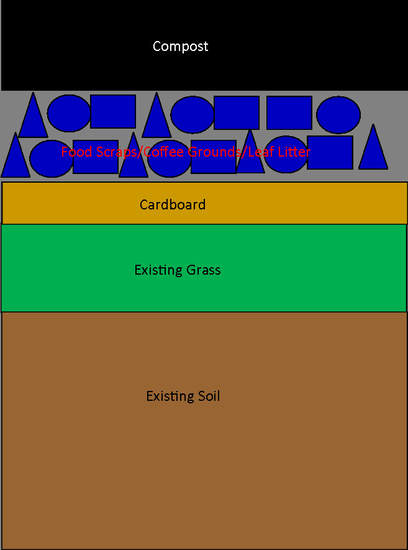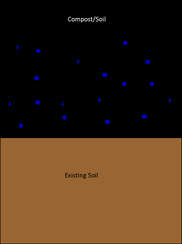|
Sheet mulching defined in its simplest terms is the layering different types of organic materials on top of the ground in order to establish a garden plot without tilling the soil. This technique can be applied to existing lawns, areas with poor soil or even over concrete or solid rock to create “soil” for growing things in.

It is basically a deep mulching technique that sidesteps the need to break up the ground underneath it by creating an environment that fosters natural soil aeration and loosening via roots, soil animals and soil microorganisms. This technique is great for those who want to try a no till style of gardening or for those that a simply allergic to hard work (like me)
How to Sheet Mulch? Sheeting mulching is very simple and very cheap to free depending on how you source the needed materials for it. You basically need to get ahold of the following, · Biodegradable weed barrier (aka paper or cardboard). · Other organic materials. (food scraps, leaf litter, compost, coffee grounds) Once you have the required materials on hand the process is really simple and can be summed up in three steps. Step 1 Place cardboard or paper on the ground where you would like to do the sheet mulching. Anchor it in place with stakes or weights to hold it in place until you can add other materials. Step Two Begin adding the raw food scraps and other non-composted materials first onto the cardboard. The idea behind this is two parts. One this material is going to be best food source for decomposing organism and two it will also be the most likely to attract unwanted critters so it best to bury it deep in the sheet mulch. Step 3 Finally cover the whole area with a thick layer of compost as deep as you can manage for that area and water deeply. Once this layering is done the next ingredient is time it can take weeks to months for the non-composted materials to fully break down and incorporate into the soil. The same is true for the grass that is underneath all this material. I have seen grass take a couple weeks to fully die when placed underneath a sheet mulch like this. The grass and other plants you are trying to smother to death will fight back by sending up shoots at the edge of the mulch if they are close enough or straight through the mulch layers if they are strong enough. These tendencies can usually be defeated by light weeding and making sure the mulching layer is deep enough. If you are starting over grass I would recommend a minimum of 6 inch of weed barrier and organic materials. This is definitely the kind of scenario where more is better and if you have the resources to do it I would go deeper. This is especially true if you are trying to establish a growing space on concrete or other impervious surfaces. Something else to also keep in mind is that as the sheet mulching decomposes it will get thinner as the material breaks down. This is not much of an issue when it’s done over decent soil but if it’s done over a hard surface or poor soils you will need to add more materials to build up and maintain the compost layer to enable better growth. For more information like this check out other article here on the Green Living Library.
0 Comments
Leave a Reply. |
AuthorHello my name is Josh Larson and I am the creator of the Green Living Library. Here on the blog you will find updates to content found in the Green Living Library as well as stories from those living the sustainable life already. Archives
December 2021
Categories
All
|

